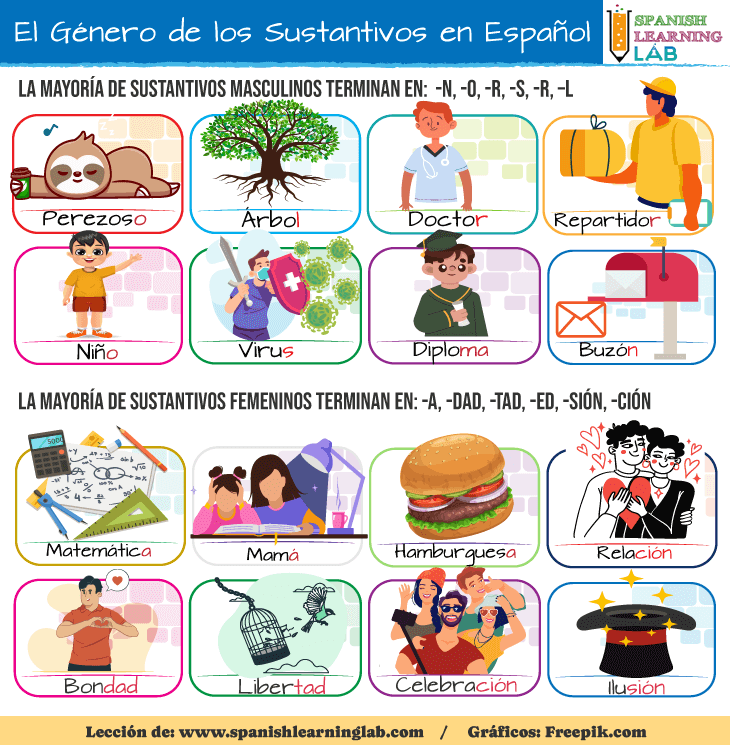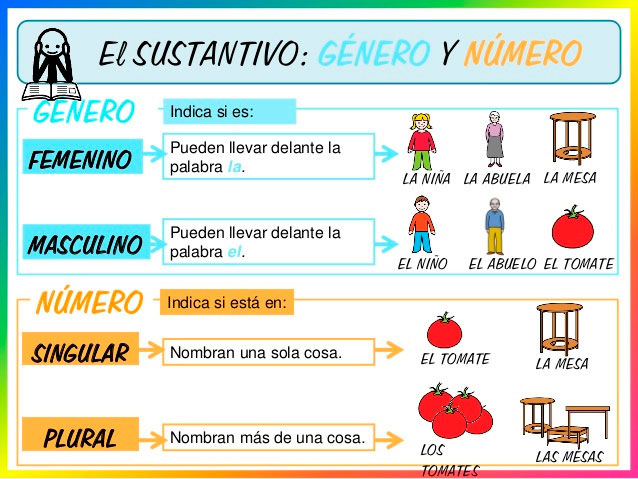Semana 2 (Ser, colores, números y ropa)
¡Hola! Did you have a good weekend (fin de semana)? This week (semana) we will learn more of ser, colors, number and clothes in Spanish.
Let’s begin! ¡Empecemos!
El verbo "ser"
Today we are going to go more in-depth with the verb "ser" = to be.
USES:
"ser" is a verb used to express identity, origin, occupation, religion, and characteristics. We use it frequently to introduce ourselves. For example:
 |
|
|
 |
 |
|
| ¿Y tú? |
Engage the class in a brief discussion about the concept of identity and characteristics. Discuss how people describe themselves and others.
How would you describe yourself? You can write it in English.
These are the conjugations of "ser" in the present tense.
Ser-to be
| I | yo | soy | we | nosotros, nosotras | somos |
| you (inf) | tú | eres | you (all)* | vosotros, vosotras | sois |
| you (form) | usted (Ud.) | es | you (all) | ustedes (Uds.) | son |
| he, she | él, ella | es | they | ellos, ellas | son |
*Just in Spain
Notice the first column is only singular, the second column is plural. The first line is first person (includes you), the second and third lines are second person (someone to whom you are talking directly), and the last line is third person (someone about whom you are talking). In the future, lines 3 and 4 may be combined, since the conjugations for each are always the same.
 A little joke!
A little joke!
Now, go back to your own description in English, and try translating it into Spanish. Look up the words you don't know - wordreference - or ask your teacher.
A practicar
Colores y números - Colors and numbers[1].
Los Colores:
Los números:
Los números
| 0 cero | 1 uno | 2 dos | 3 tres |
| 4 cuatro | 5 cinco | 6 seis | 7 siete |
| 8 ocho | 9 nueve | 10 diez | |
| 11 once | 21 veintiuno | 31 treinta y uno | 41 cuarenta y uno |
| 12 doce | 22 veintidós | 32 treinta y dos | 42 cuarenta y dos |
| 13 trece | 23 veintitrés | 33 treinta y tres | 43 cuarenta y tres |
| 14 catorce | 24 veinticuatro | 34 treinta y cuatro | 44 cuarenta y cuatro |
| 15 quince | 25 veinticinco | 35 treinta y cinco | 45 cuarenta y cinco |
| 16 dieciséis | 26 veintiséis | 36 treinta y seis | 46 cuarenta y seis |
| 17 diecisiete | 27 veintisiete | 37 treinta y siete | 47 cuarenta y siete |
| 18 dieciocho | 28 veintiocho | 38 treinta y ocho | 48 cuarenta y ocho |
| 19 diecinueve | 29 veintinueve | 39 treinta y nueve | 49 cuarenta y nueve |
| 20 veinte | 30 treinta | 40 cuarenta | |
| 50 cincuenta | 100 cien | 150 ciento cincuenta | 200 doscientos |
| 51 cincuenta y uno | 101 ciento uno | 151 ciento cincuenta y uno | 201 doscientos uno |
| 60 sesenta | 110 ciento diez | 160 ciento sesenta | 300 trescientos |
| 61 sesenta y uno | 111 ciento once | 161 ciento sesenta y uno | 400 cuatrocientos |
| 70 setenta | 120 ciento veinte | 170 ciento setenta | 500 quinientos |
| 71 setenta y uno | 121 ciento veintiuno | 171 ciento setenta y uno | 600 seiscientos |
| 80 ochenta | 130 ciento treinta | 180 ciento ochenta | 700 setecientos |
| 81 ochenta y uno | 131 ciento treinta y uno | 181 ciento ochenta y uno | 800 ochocientos |
| 90 noventa | 140 ciento cuarenta | 190 ciento noventa | 900 novecientos |
| 91 noventa y uno | 141 ciento cuarenta y uno | 191 ciento noventa y uno | |
| 1.000 mil | 100.000 cien mil | ||
| 2.000 dos mil | 1.000.000 un millón | ||
| 3.000 tres mil | |||
| 4.000 cuatro mil | |||
| 5.000 cinco mil | |||
| 6.000 seis mil | |||
| 7.000 siete mil | |||
| 8.000 ocho mil | |||
| 9.000 nueve mil | |||
| 10.000 diez mil | |||
Let's play bingo!
Write your own bingo card. Use numbers from 1 to 75.

https://letsplaybingo.io Your teacher will use this link to call numbers in Spanish! Good luck!
Género y número de los sustantivos - Gender and number of nouns.
Do you know what a noun is?
A noun (sustantivo) is a word used to identify any of a class of people, places, or things (common noun - boy, mountain, house), or to name a particular one of these (proper noun - Jonas, St. George).
Let's see if it makes sense:
Gender (género) in Spanish:
Nouns in English in Spanish are very similar ways, however, there is a key difference between the nouns of the two languages: ALL Spanish nouns have gender (feminine/ masculine).
Other than for people, this gender is arbitrary, this means that a male can use a feminine object. For example: A man wears a tie - Un hombre lleva una corbata. In this example, "man" is masculine whereas "tie" is feminine. A woman wears a dress - Una mujer lleva un vestido. Here "dress" is masculine.
So, how do we know if a noun is masculine or feminine? We need to memorize these generalizations:

There are always exceptions, a few include: el día, el problema o la mano, la foto(grafía), la moto(cicleta).
There are a group of exceptions. Most words in Spanish come from Latin. Those that come from other languages are generally masculine.
There are a group of words that we use that come from Greek, and so are masculine. Most of these are cognates in English: el problema, el drama, el síntoma, el sistema, el poema, el tema, el profeta, el mapa, el planeta, etc.

Number (singular or plural) in Spanish:
In Spanish the nouns also have number: singular or plural.
The singular form is the standard one and it is the one that appears in the dictionary.
On the other hand, in the plural form the nouns end in –s or –es.
So, when do we use -s or -es to form the plural forms?
The plural form of nouns is formed on the basis of its singular form:
- when a noun in its singular form ends in a vowel, the plural is formed by adding at the end –s.
- casa > casas
- when the singular form of a noun ends in a consonant, the plural form is formed by adding at the end –es.
- profesor > profesores
There are also exceptions:
- Singular nouns ending in –s do not change in the plural.
- el lunes > los lunes.
- Nouns ending in -z, it changes to –c resulting in a –ces ending.
- lápiz > lápices.
- add -es if the noun ends in í or ú.
- el jabalí = los jabalíes
Summary:

La Ropa - Clothes
Did you know that it is common in Spanish speaking countries to dry one's clothes by hanging them outside the window?
La ropa
| el abrigo | coat |
| la bata | robe |
| el bikini | bikini |
| la blusa | blouse |
| la bufanda | scarf |
| los calcetines | socks |
| la braga | underwear for women |
| el calzoncillo | underwear |
| la camisa | shirt |
| la camiseta | t-shirt |
| el chaleco | vest |
| la chaqueta | jacket |
| el cinturón | belt |
| la corbata | tie |
| la falda | skirt |
| la gorra | cap |
| el gorro | hat without brim, beanie |
| los guantes | gloves |
| el impermeable | raincoat |
| los vaqueros/los jeans | jeans |
| las medias | hose |
| la minifalda | miniskirt |
| el mono | overalls |
| los pantalones | pants |
| el piyama | pajama |
| el sostén, el sujetador | bra |
| el sombrero | hat |
| la sudadera | sweatshirt |
| el jersey/suéter | sweater |
| el traje | suit |
| el traje de baño | swimsuit |
| el uniforme | uniform |
| el vestido | dress |
| las botas | boots |
| las chanclas, las zapatillas | flipflops |
| las pantuflas | slippers |
| las sandalias | sandals |
| los tenis | running shoes |
| los zapatos | shoes |
| el bolsillo | |
| el botón | button |
| el cierre | zipper |
| el cordón | shoelace |
| la manga | sleeve |
| la ropa interior | underwear in general |
Watch this video to learn about clothes in Spanish.
To help you memorize these words, why don't use practice with these flashcards?
In order to talk about what people wear, we need to learn to conjugate the verb "llevar".
| Yo | llevo | Nosotros/as | llevamos |
| Tú | llevas | Vosotros/as | lleváis |
| Usted/ Él/ Ella | lleva | Ustedes/ Ellos/ Ellas | llevan |
Secret student
Look around the class, choose one of your classmates and write what clothes they're wearing. Don't say their name!
- Once you hear your classmate's descriptions, try to guess who they are talking about.
La ropa, vocabulario suplementario
| los aretes, los pendientes | earrings | el anillo | ring | el collar | necklace |
| los lentes | glasses | las gafas | sunglasses | la billetera | wallet |
| la cartera, el bolso | purse | la pulsera | bracelet | el reloj | watch |
| las llaves | keys | el paraguas | umbrella | el pañuelo | handkerchief |
¡A escribir!
Can you tell what these people's clothes look like?
For example: la niña lleva un vestido amarillo.


If you want to practice more, this website has more autocorrect activities: https://arche-ele.com/la-ropa-vocabulario-aprende-espanol-clothes-spanish
¿Cómo se llama tu mejor (best) amigo/a?
¿Cómo es tu mejor amigo?
¿Cuál es tu color favorito?
¿Qué ropa llevas?
¿Qué lleva tu compañero/a?
¿De dónde eres?
¿De qué color es la camiseta?
ser/colores/números/género y número/ropa
- https://isabelanaluisa.com/los-colores-y-los-numeros-en-espanol-para-extranjeros/ ↵

